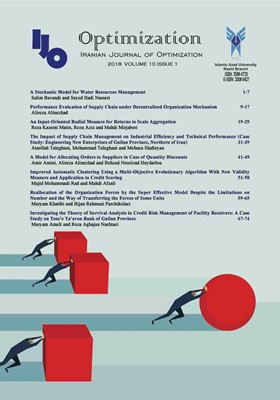Investigating the Theory of Survival Analysis in Credit Risk Management of Facility Receivers: A Case Study on Tose'e Ta'avon Bank of Guilan Province
الموضوعات :
Maryam Ameli
1
,
Reza Aghajan Nashtaei
2
![]()
1 - M.Sc Student, Business management, Rasht Branch, Islamic Azad University, Rasht, Iran
2 - Department of Business management, Rasht Branch, Islamic Azad University, Rasht, Iran
الکلمات المفتاحية: survival analysis, credit risk management, Tose-Taavon Bank,
ملخص المقالة :
Nowadays, one of the most important topics in risk management of banks, financial, and credit institutions is credit risk management. In this research, the researchers used survival analytic methods for credit risk modeling in terms of the conditional distribution function of default time. As a practical task, the authors considered the reward credit portfolio of Tose'e Ta'avon Bank of Guilan Province and estimate the bank’s probability of default based on the survival analysis method. In order to analyze and verify the research hypothesis, firstly, the researcher estimated the survival analysis, survival function, and then the value of the probability of default function by three parametric, semi-parametric (proportional hazards model), and non-parametric methods. Finally, the author compared these three methods by using the ROC method. In order to analyze data, SPSS, SAS, R, and Minitab softwares were used. The results revealed that the parametric model was better and more suitable than the other models. After the parametric model, it was observed that, the semi-parametric model (proportional hazards model) and then the non-parametric model proved to be the best models. The results of this research suggest using rating or credit score in banks, because, in addition to the proper management of allocation of facility to customers, using a credit score as an explanatory variable can result in more efficient and more accurate estimations of default probability.
Baba, N., & Goko, H. (2006). Survival analysis of hedge funds. Institute for Monetary and Economic Studies and Financial Markets Department, 6.
Bekhet, H. A., & Eletter, S. F. K. (2014). Credit risk assessment model for Jordanian commercial banks: Neural scoring approach. Review of Development Finance, 4(1), 20-28.
Cao, R., Vilar, J. M., Devia, A., Veraverbeke, N., Boucher, J. P., & Beran, J. (2009). Modelling consumer credit risk via survival analysis.
Carling, K., Jacobson, T., & Roszbach, K. (1998). Duration of consumer loans and bank lending policy: dormancy versus default risk (No. 70). Sveriges Riksbank Working Paper Series.
Karani, H., & Aghaeipoor, M. (2014). Application of survival analysis theory in risk management of facility receivers; Case study of Meskan Bank. Ravand Quarterly Journal, 21, 65 – 66. 200 - 175.
Malik, M., & Thomas, L. (2006). Modelling credit risk of portfolio of consumer loans, University of Southampton. School of Management Working Paper Series No. CORMSIS-07-12.
Narain, B. (1992). Survival Analysis and the Credit Granting Decision, [in:] LC Thomas, J. Crook N., DB Edelman (eds.), Credit Scoring and Credit Control.
Taghavi Takyar, S.M. (2015). Comparison of credit risk in artificial neural network Models (RBF) and logistic regression in Tose'e Ta'avon Bank of Guilan Province. Unpublished thesis, Department of Business Management, Rasht Branch, Islamic Azad University, Rasht, Iran.
Taghva, M. R., Olfat, L., & Hosseini Bamakan, S. M. (2009). Application of data mining techniques for improving customer relationship management in banking industry. Third Data Mining Conference, Poster No. 11.
Yazdan Panah, A., & Shakibhaji aghaie, S. (2009). Factors affecting liquidity risks of banks (A case study of Mellat Bank). Journal of Financial Studies, 3, 27-54.
Yurdakul, F. (2015). Macroeconomic modeling of credit risk for banks. Procedia Social and Behavioral Sciences, 109, 784-793.


